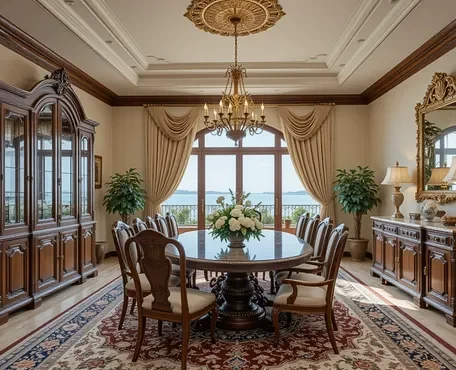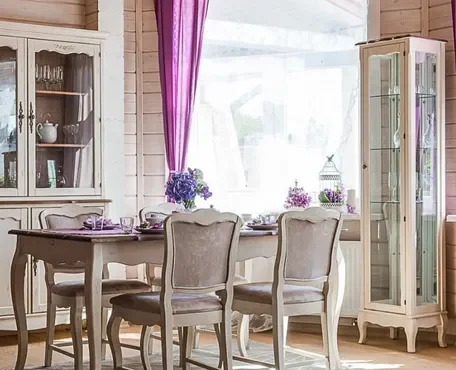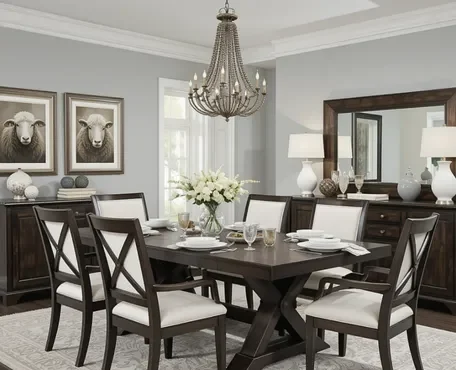
Small Dining Room: 21 Smart Tips to Make It Feel Spacious
The dining room is the heart of the home—where conversations unfold over meals, and where friends and family gather to celebrate special occasions. But if your dining space feels tight or closed in, it can hinder both comfort and style. The good news? You don’t need a complete renovation to open things up. A few clever design strategies can create the illusion of more space. Here are 21 transformative tips to make your dining room look and feel bigger.
Here’s a long, detailed article titled “21 Smart Tips to Make Your Dining Room Look Bigger”

1. Choose a Light Color Palette
Light and neutral shades reflect more light and instantly make any room feel more expansive. Opt for whites, soft grays, pale beiges, or cool pastels for walls, trim, and even furniture.To make a small dining room feel larger and more inviting, use a light color palette with soft whites, grays, beiges, or pastels. Paint walls, trim, and ceilings in light shades to reflect more light and create openness. Choose light-toned or transparent furniture, and use neutral textiles like sheer curtains and light rugs. Add mirrors to reflect light and keep accent colors minimal for a cohesive, airy look.

2. Use Mirrors Strategically
Using mirrors strategically is a powerful way to enhance the sense of space in a small dining room. Mirrors reflect both natural and artificial light, making the room appear brighter and more open. Placing a large mirror on one wall—particularly across from a window or a light fixture—amplifies light and creates the illusion of depth, visually doubling the space. Even smaller mirrors, when grouped creatively or used as part of a gallery wall, can contribute to this effect while adding a decorative touch.

3. Select a Round Table
Selecting a round dining table is an excellent choice for small or awkwardly shaped dining rooms. Unlike rectangular or square tables, round tables lack sharp corners, which improves the flow of movement around the room and reduces visual clutter. This shape naturally creates a more open feel and helps avoid the cramped sensation that can come with bulky, angular furniture. Round tables also foster a more intimate and social dining experience, allowing everyone to face each other equally, which is ideal for conversation. Additionally, many round tables come with pedestal bases, offering more legroom and flexibility with seating arrangements. If needed, smaller round tables can be paired with stackable or backless chairs to further save space.

4. Keep Window Treatments Light
Keep window treatments light to maintain an open, airy feel in a small dining room. Avoid heavy drapes that can make the space feel closed in. Instead, choose sheer curtains, linen panels, or Roman shades that allow natural light to flow through. If privacy isn’t a concern, consider leaving windows bare to maximize brightness and create a more expansive look.

5. Incorporate Glass or Acrylic Furniture
A glass dining table or lucite chairs help reduce visual clutter. These materials are “invisible” to the eye and create a more open, airy look.Incorporate glass or acrylic furniture to make a small dining room feel more spacious. A glass dining table or lucite chairs reduce visual clutter because their transparent design is nearly invisible to the eye, helping the room appear lighter, more open, and less crowded.

6. Go Minimal with Decor
Too many accessories or bulky centerpieces can overwhelm a small dining room. Choose a single statement piece or a trio of minimal accents, and keep surfaces clean and tidy.Go minimal with decor to avoid overwhelming a small dining room. Instead of cluttering the space with too many accessories or bulky centerpieces, opt for a single statement piece or a trio of simple accents. Keep surfaces clear and tidy to maintain a clean, uncluttered look that enhances the sense of openness.

7. Maximize Natural Light
Natural light makes any room feel larger. Keep windows unobstructed and use light-reflecting finishes like high-gloss paint, metallic accents, and glossy ceramics to enhance brightness.Maximize natural light to make a small dining room feel more spacious. Keep windows unobstructed to allow as much natural light in as possible. Use light-reflecting finishes, such as high-gloss paint, metallic accents, and glossy ceramics, to enhance brightness and create an airy, open atmosphere.

8. Choose Low-Profile Seating
Dining chairs without arms and with lower backs create the illusion of more space and less visual weight, keeping the room looking open.Choose low-profile seating to create a more spacious feel in a small dining room. Dining chairs without arms and with lower backs reduce visual weight, making the room appear more open and less cluttered. This design allows for better flow and enhances the sense of space.

9. Float Your Furniture
Leave space between the furniture and the wall. It may sound counterintuitive, but floating your table or chairs slightly away from the walls prevents the space from feeling cramped or boxed in.Float your furniture by leaving space between it and the walls. While it may seem counterintuitive, positioning your table and chairs slightly away from the walls creates a sense of openness and prevents the room from feeling cramped or boxed in. This arrangement improves flow and enhances the feeling of spaciousness.

10. Embrace Vertical Lines
Add vertical paneling, tall artwork, or floor-to-ceiling shelving to draw the eye upward. Vertical lines give the room height, which enhances the feeling of spaciousness.Embrace vertical lines to enhance the sense of space in a small dining room. Add vertical paneling, tall artwork, or floor-to-ceiling shelving to draw the eye upward. Vertical lines create the illusion of height, making the room feel more expansive and open.

11. Install a Statement Light Fixture
A chandelier or pendant light draws the eye up and adds drama. Just ensure it’s scaled appropriately—not too large or it may dominate the space.Install a statement light fixture, such as a chandelier or pendant light, to add drama and draw the eye upward. This creates a focal point and enhances the room’s height. Just be sure the fixture is appropriately scaled—not too large, as it could overwhelm the space.

12. Use a Tone-on-Tone Color Scheme
Using varying shades of the same color for walls, furniture, and decor creates harmony and prevents visual segmentation, which can make a room feel smaller.Use a tone-on-tone color scheme by incorporating varying shades of the same color for walls, furniture, and decor. This creates harmony and flow, preventing visual segmentation, which can make the room feel more cohesive and spacious.

13. Opt for Open-Base Furniture
Tables, chairs, and consoles with exposed legs or open bases allow light to pass through, creating a lighter and less bulky appearance.Opt for open-base furniture, such as tables, chairs, and consoles with exposed legs or open bases. This design allows light to pass through, creating a lighter, less bulky appearance and helping the room feel more open and airy.
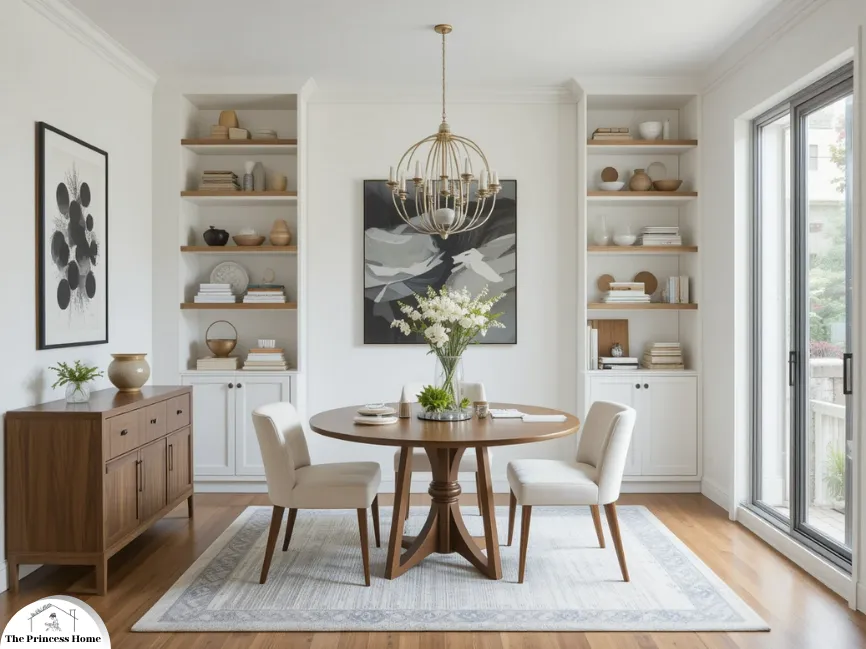
14. Streamline Storage
If your dining room doubles as a storage zone, choose a slender credenza or sideboard with clean lines. Use built-in or floating shelves to minimize floor usage.Streamline storage by opting for a slender credenza or sideboard with clean lines if your dining room also serves as a storage area. Built-in or floating shelves are ideal for maximizing vertical space and minimizing floor clutter, keeping the room feeling open and organized.

15. Lay Down the Right Rug
A light-colored, low-pile rug that’s large enough to fit the entire table and chairs helps define the space and unify the layout without overwhelming it.Lay down the right rug by choosing a light-colored, low-pile option that’s large enough to fit the entire table and chairs. This helps define the dining area and unifies the layout without overwhelming the space, maintaining an open, airy feel.

16. Stick to Symmetry
Stick to symmetry to create a visually pleasing and balanced dining room. Position chairs evenly, use matching light fixtures, and aim for balance in your table decor. Symmetrical layouts help reduce clutter and make the space feel more organized and serene.

17. Paint the Ceiling
Paint the ceiling the same light color as the walls, or a shade lighter, to make the ceiling appear higher and the room feel more spacious. This subtle change enhances the room’s openness and adds a sense of height.Painting the ceiling in a light, complementary color helps reflect more light and enhances the overall brightness of the room. It creates a seamless, expansive look, drawing the eye upward and giving the impression of more vertical space. For added effect, you can also consider a soft, glossy finish on the ceiling to subtly reflect light and further amplify the feeling of airiness.

18. Keep Flooring Continuous
Keep flooring continuous by extending the same material from adjacent rooms into the dining area. This creates a seamless transition between spaces, making the dining room feel larger and more connected to the rest of the home. The consistent flooring reduces visual breaks and enhances the room’s flow.
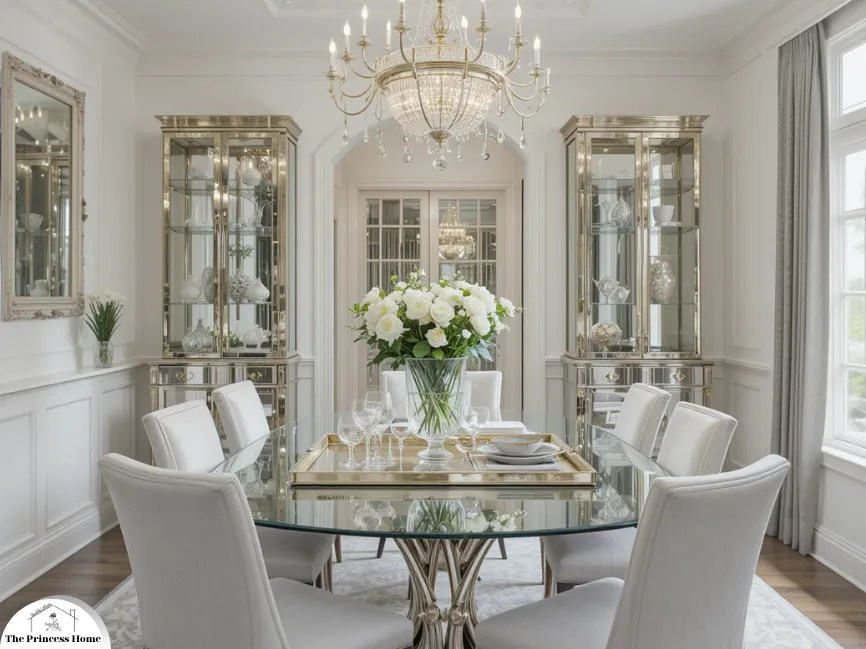
19. Incorporate Reflective Surfaces
Incorporate reflective surfaces, such as mirrored trays, glossy finishes, glass-front cabinetry, and metallic accents, to bounce light and create the illusion of a larger space. These surfaces enhance brightness, add dimension, and contribute to a more open, airy feel in the dining room.

20. Downsize the Furniture Scale
Downsize the furniture scale by choosing a table and chairs that fit the proportions of your dining room. Avoid large, bulky pieces like oversized buffets or overstuffed chairs. Opt for compact, well-proportioned furniture that meets your needs without overwhelming the space. This keeps the room feeling open and functional.

21. Create Visual Flow to Adjacent Rooms
If your dining room opens to another area, use consistent color schemes or similar styles to encourage the eye to travel further, extending the visual boundaries of your space.Create visual flow to adjacent rooms by using consistent color schemes or similar styles throughout. This encourages the eye to move seamlessly from the dining room to the connected spaces, making the entire area feel larger and more cohesive.
Conclusion
You don’t need to knock down walls to make your dining room feel more open. With these 21 tips—ranging from smart furniture choices to subtle decor shifts—you can make your dining space look bigger, brighter, and more welcoming. Whether you’re entertaining guests or enjoying a quiet family dinner, a thoughtfully arranged room enhances both comfort and style.
Here are some frequently asked questions related to the article :
Q1: What color makes a small dining room look bigger?
A: Light, neutral shades such as white, soft gray, pale beige, and light pastels help reflect natural light, which creates the illusion of a larger space. Avoid dark, heavy tones that can absorb light and make the room feel closed in.
Q2: Is a round or rectangular table better for a small dining room?
A: A round table is often better for small dining rooms because it promotes better flow and takes up less visual space. It also allows for more flexible seating arrangements.
Q3: Can mirrors really make my dining room feel larger?
A: Yes! Mirrors reflect light and scenery, which tricks the eye into perceiving more space. Placing a mirror opposite a window is especially effective in brightening and expanding the room visually.
Q4: What kind of furniture works best in a small dining space?
A: Opt for compact, low-profile furniture with open or slender legs. Glass, acrylic, and light wood finishes work well. Avoid bulky, overstuffed pieces that consume space both physically and visually.
Q5: How should I choose lighting for a small dining room?
A: Choose a light fixture that adds height and style without overwhelming the room. A sleek chandelier or a glass pendant draws the eye upward while maintaining visual openness. Wall sconces can also save table or floor space.
Q6: Do rugs make small dining rooms feel bigger or smaller?
A: The right rug can make the space feel more cohesive and expansive. Choose a light-colored, low-pile rug that extends at least 24 inches beyond the edges of your dining table on all sides. Avoid heavy patterns that visually crowd the space.
Q7: How can I create storage in a small dining room without making it feel cramped?
A: Use multi-functional furniture like a bench with storage, a narrow sideboard, or floating shelves. Keep the lines clean and the finishes light. Wall-mounted storage also helps save floor space.
Q8: Should the dining room match adjacent rooms to look bigger?
A: Yes, using a consistent color scheme or flooring between rooms creates visual flow, making your dining space feel more like an extension of the entire area rather than a closed-off section.
Q9: Can I hang artwork in a small dining room?
A: Absolutely—just choose artwork that enhances vertical space. Opt for one large piece rather than several small ones to avoid a cluttered look. Frames in light or metallic finishes also help reflect light.
Q10: How do I keep my small dining room from feeling cluttered?
A: Stick to minimal decor, tuck away unnecessary items, and keep surfaces clear. Incorporate only a few well-chosen pieces that serve both function and style. Remember: less is more in small spaces.


